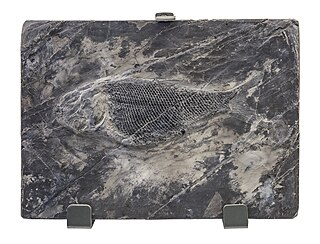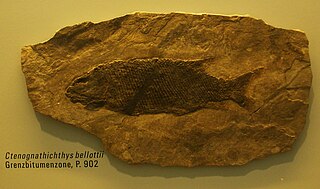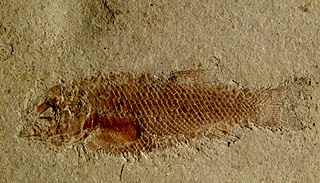
Saurichthys is an extinct genus of predatory ray-finned fish from the Triassic Period. It is the type genus of the family Saurichthyidae, and the most speciose and longest lasting genus in the family. This family also includes the Permian Eosaurichthys (China) and the Jurassic Saurorhynchus from Europe and North America, though it may be more appropriate to treat these as subgenera of Saurichthys, due to the genus Saurichthys otherwise being paraphyletic.

Archaeolepidotus is an extinct genus of prehistoric marine holostean bony fish that lived during the latest Permian or earliest Triassic in what is now Trentino-Alto Adige, Italy. It contains a single species, A. leonardii. It is among the earliest known fossil neopterygians, and is usually recovered as a semionotiform, but others recover it as a parasemionotiform.

Australosomus is an extinct genus of prehistoric ray-finned fish that lived during the Early Triassic epoch in what is now Greenland, Kenya, Tanzania, Madagascar, South Africa and Canada.
Gyrolepidoides is an extinct genus of prehistoric bony fish that lived during the Late Triassic epoch in what is now Mendoza, Argentina.
Agecephalichthys is an extinct genus of prehistoric freshwater "palaeonisciform" ray-finned fish that lived during the Anisian age. It contains a single species, A. granulatus from the Hawkesbury Sandstone in what is now New South Wales, Australia.

Asialepidotus is an extinct genus of prehistoric marine ray-finned fish that lived during the Ladinian stage of the Middle Triassic epoch. It contains a single species, A. shingyiensis, from Guizhou, China.
Eosaurichthys is an extinct genus of saurichthyid ray-finned fish that lived during the late Permian epoch in what is now China.
Crenilepis is an extinct genus of prehistoric marine ray-finned fish that lived in the seas of present-day Europe during the Middle Triassic epoch. It contains a single species, C. sandbergi from the Anisian of Germany, Spain, and the Besano Formation of the Swiss-Italian border.
Luganoia is an extinct genus of prehistoric bony fish that lived during the Anisian and Ladinian ages of the Middle Triassic epoch. Fossils were recovered from the Besano Formation of Monte San Giorgio and Besano area and from the Zhuganpo Member of Guizhou, South China. It was also reported from the Ladinian of Spain.

Ctenognathichthys is an extinct genus of prehistoric marine ray-finned fish that lived during the Middle Triassic epoch of Europe, in the former Tethys Ocean.

Acentrophorus is an extinct genus of prehistoric freshwater and marine ray-finned fish from the Roadian to the Wuchiapingian of England, Germany (Kupferschiefer), Italy and Russia. There may also be a Triassic occurrence in Australia.

Allolepidotus is an extinct genus of prehistoric marine neopterygian ray-finned fish from the Middle Triassic epoch of what is now Italy, Spain, and Switzerland. It was formerly referred to the halecomorph order Panxianichthyiformes, but is now thought to be a member of the Ionoscopiformes.

Bobasatrania is an extinct genus of prehistoric marine ray-finned fish that survived the Permian-Triassic extinction event. Fossils of Bobasatrania were found in beds of Changhsingian to Ladinian age. It was most speciose during the Early Triassic.

Brembodus is an extinct marine pycnodontid fish, the type genus of the family Brembodontidae. It contains a single species, B. ridens, known from the Late Triassic Calcare di Zorzino formation of Cene, Italy.

Colobodus is an extinct genus of marine Triassic ray-finned fish of the family Colobodontidae and order Perleidiformes. Fossils have been found in Europe and China, encompassing the former Tethys Ocean. It could reach body lengths of about 70 cm.

Dipteronotus is an extinct genus of stem-neopterygian ray-finned fish that existed during the Middle and Late Triassic epochs in what is now Europe and Morocco. As a typical feature, it had several ridge scales in front of its dorsal fin that created a spine-like structure.

Dandya is an extinct genus of marine ray-finned fish belonging to the family Dapediidae. It contains one species, D. ovalis. It is known from the Late Triassic-aged Zorzino Limestone of Lombardy, northern Italy and the Seefeld Formation of Austria.

Gyrolepis is an extinct genus of prehistoric ray-finned fish from the Middle-Late Triassic epochs in what is now Europe. It is known both from complete specimens and isolated skeletal elements, such as scales or teeth.

Prohalecites is an extinct genus of ray-finned fish from the Ladinian and possibly Carnian (Triassic) of Italy. It is the oldest known teleosteomorph, a group that includes extant teleosts and their close fossil relatives.

Thoracopteridae is an extinct family of prehistoric bony fish classified with the order Peltopleuriformes, containing four genera: Thoracopterus, Gigantopterus, Potanichthys and Italopterus. This lineage of Triassic flying fish-like Perleidiformes converted their pectoral and pelvic fins into broad wings very similar to those of their modern counterparts. However, this group is not related to modern flying fish from the family Exocoetidae, instead being a case of convergent evolution.



















